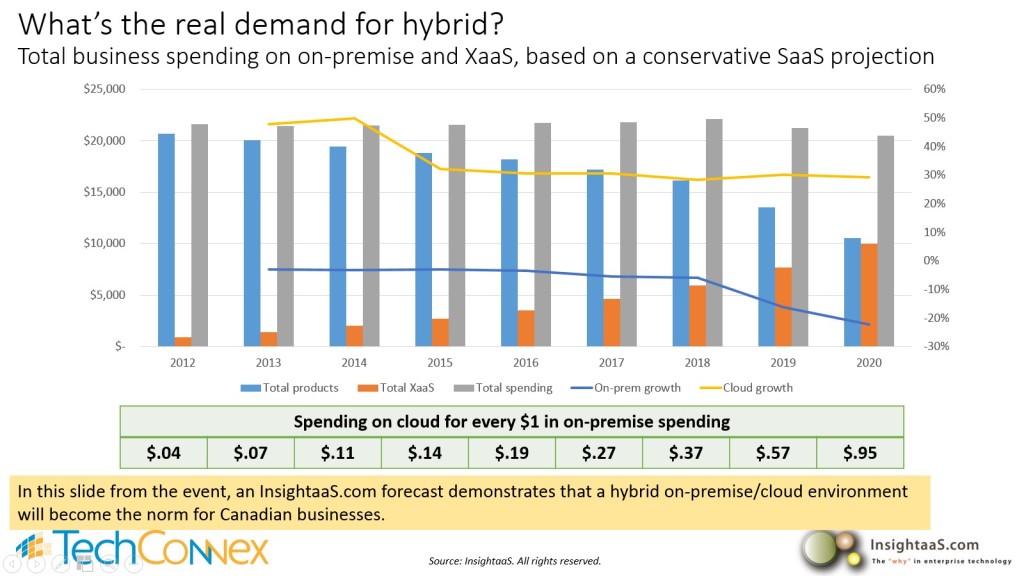Over the past year, the cloud marketplace in Canada has experienced profound change. While XaaS adoption has accelerated across the size and industry spectrum, moving market spend closer to the parity for cloud and traditional infrastructure InsightaaS has forecast for 2020, global hyperscale providers have set up shop in Canada to support data residency and demand for locally sourced cloud services. Microsoft’s establishment of two Canadian data centres and the recent launch of the AWS (Central) Canada Region in Quebec represent the most dramatic transition; however, shifts in delivery capacity have occurred in the colo space as well, with the entry of new players and the exit of others. At the same time, mergers – notably the Dell EMC deal – and new partnerships that realign the delivery of public and private services – involving AWS, IBM and VMware, for example – have emerged with the promise of more and better enablement of digital transformation, complicating sourcing and implementation decisions for Canadian businesses.

Throughout these changes, VMware has continued to train its laser focus on hybrid cloud, the service delivery mode that is at once the most prevalent model and the most complex to deploy. To help customers navigate this complexity, the company has continued to refine its cloud solution set, developing additional management capability and easing provisioning in an effort to redefine and simplify the hybrid experience. But what of VMware go-to-market? How is the company honing its own positioning, weathering the storm in a market that is currently characterized by constant change? At the VMware vForum Toronto 2016 event, InsightaaS had an opportunity to discuss these challenges, technology innovation, and the colour of new opportunity that cloud provides in Canada with Peter Near, national director, systems engineering at VMware Canada.

Mary Allen, chief content officer, InsightaaS: I have a sense that less often than might be the case with other companies AWS goes through a channel program when they are onboarding new customers. But VMware works with an extensive partner ecosystem. So in your emerging relationship with AWS in Canada, how will partners play?
Peter Near, national director, systems engineering at VMware Canada: We are doing a lot of work with AWS. That service [based on the strategic partnership between VMware and AWS announced this fall] is VMware Cloud on AWS, so it is a VMware service that is sold by VMware through the VMware channels – which operates on the AWS Cloud. The thing that I find interesting about this announcement – along with a number of others from Canada – is that cloud adoption in the Canadian enterprise has been comparatively slow vs. the US because until recently we haven’t had a lot of Canadian soil public cloud providers available to us. This is an interesting time for the VMware solution set and for some of the Canadian soil public cloud providers because we now have a lot more Canadian enterprises that are looking seriously at a public cloud strategy at the same time that we have technology capabilities and some learnings from the early movers in the US who say “here’s how I do it” in a more holistic way. They say, “I’ve got my private cloud and my security policies in place, and that private cloud now extends into the public cloud.” This means users no longer need to manage cloud siloes, they are managing cloud strategy across these areas. Based on the conversations that I have been having with customers in Canada, this [agreement between VMware and AWS] is well timed. The Canadian soil presence of cloud providers has made this topic incredibly relevant for our customers.
Allen: I agree with you that we haven’t had a major player like Amazon in Canada until just this year. Though they launched public cloud resources in Canada before anyone else, IBM took some time to announce and we now finally have Microsoft facilities here as well. But what about some of the smaller providers? What kind of strategy do you have for the smaller Canadian hosting providers and even for some of the larger companies that do not appear on your list.

Near: The VMware strategy is mostly about choice. We have customers who are now looking to build their cloud strategy who have existing relationships that they may want to leverage. They may have preferred providers that they work with us. In the same way we did on the compute side, where you can move your workloads from HP, Dell or other systems to any cloud, for us, those Canadian providers, whether they are small, medium or large, represent choice for our customers. We want to be the layer that provides abstraction between them.
Allen: But you are not talking about these in your public announcements. You are talking about IBM, Google, OVH and Amazon. What about some smaller organization like Canadian Web Hosting, which has been around forever?
Near: Those smaller organizations are part of our vCloud Air network. A lot of the press releases have focused on some of the newer announcements. I’m not familiar with that particular provider, but there are a lot of vCloud Air partners in Canada. The difference with some of the recent announcements is that they are based on the Cloud Foundations platform from VMware, which is a single platform, cloud-in-a-box kind of approach that is private cloud and public cloud with AWS, or public cloud with SoftLayer [IBM cloud]. This is a very specific offering and a lot of our vCloud Air partners will have that offering coming soon as well, but they also have [other] specific offerings available today that differentiate them in the marketplace. One vCloud Air network partner may specialize in DR-as-a-Service, or another might specialize in managed services. So these specialize, while the recent announcements focus more on delivery of the Cloud Foundation.
Allen: Which these types of partners do you think will be most important for VMware in Canada as you make those linkages with public cloud?
Near: The honest answer is it varies by customer. If I’m working with a customer who really wants a managed service provider, a vCloud Air partner network would be a perfect match. But if I’m working with a customer that requires much larger outsourcing of infrastructure for hybrid cloud, some of the larger public cloud providers would be a better fit for that.
Allen: Another question I had came out of the demo in the vForum presentation this morning. It was pretty amazing to see the automated, policy-based migration of workloads to the SoftLayer cloud in action. But this is a lot of control for the average customer to give up; while automation may relieve customers of the burden of managing cloud infrastructure, at the same time, they have to relinquish control over who their cloud provider might be, and over the cost of the service. What are the policy-based decision options presented in the drop down menu based on? Is it based on cost, reliability or availability of resources delivered by the partner?
Near: The Cross Cloud Architecture is intended to make that simple. You want to remove the complexity that is underneath, but in those policies, the users can define what they want. One of the Cross Cloud services is costing; we can reach out and determine the cost of running a particular workload on your private cloud or in different public clouds and use that cost as one of the decision points. In that case, you are often presenting the information to someone who is requesting a service so they can have it for those trade-offs in cost vs. other policy attributes they are looking for.
Allen: So there is another place in the vRealize package where you could feed in other criteria that might be more important than what I saw in the demo drop down menu, which was basically resource need?
Near: Correct. The customers define the policies that they want to look at. The other one that we did not go into in the demo is security policy. This represents a difference in thinking about how you deploy your cloud applications because any application is going to have a security policy that is associated with it. It’s going to have network policy which defines how it will communicate; it’s going to have a storage and performance policy associated with it. Those policies come together to help the user decide which is the best way to run the application, and does he/she want to automate that or not?
Allen: So the decision will depend on the customer; and some will want to abdicate that responsibility assuming VMware has a better sense of what is the best option. Do you have a couple of models, or templates that you use to make suggestions to customers, or do they have to go through and make decisions on each of these compute/security/storage/networking buckets?
Near: The user can determine who within the organization sets these policies, and move the decision there. One of the tools we have is vRealize Automation, which defines a blueprint for the service that will be built – and the organization can have the network administrator define an approved network or security policy for that application as input to that. Policies that are determined and approved by the experts within the organization become the building blocks for someone else to put together in an application. This can be totally automated, or it can be part of the overall workflow around deployment and the decisions that need to be made along the way.
Allen: Involved in presales conversations with VMware Canada customers, you must have your finger on the pulse of the market. At what stage do you find the majority of Canadian customers? When I hear about a product like Photon, I feel that is pretty far out for the majority – as is understanding of containers beyond the development community. How many Canadian are actually having discussions about cloud-native applications and the platforms that VMware has to support these?
Near: The short answer is several Canadian customers are having these conversations with us. However, there is a conflict within many of the organizations that we work with and within the industry in general between the security and control that needs to happen from an infrastructure perspective, and the speed that the company needs to operate at in order to get some of these applications out. You often have the developers working on behalf of business to get something out very quickly – to move the needle – and the operations team trying to make sure that you are doing that is a safe, secure and manageable way. A lot of Canadian customers that I’m taking to are in the middle of that challenge right now, trying to figure out what their DevOps approach to connect those things together will be.
We’re seeing a mix. For some of the companies that are developing cloud first applications, they are doing that with a cloud native platform, but then building additional layers of security around it. For customers that have a mix of applications, we are having conversations around how do you extend the VMware platform with VMware Integrated Containers so that your security, storage and network policies apply to some of those modern applications as well. So it’s a bit of both. In the enterprise market, it’s looking at the intersection of those two – and that’s where the Integrated Containers conversation is really interesting for our customers.
Allen: Is there a particular vertical that you are having better conversations with? In Canada, it has always been the financial services community that has led the adoption of advanced technology.
Near: Across the large verticals, I would say any large customers that are talking directly to end customers are there. If you are looking to put a mobile application directly in your customer’s hand, you are looking to get that application out there as a competitive differentiator – to build a really good piece of technology that will get directly into the hands of your consumers. So banks or retail, for example, that have direct to consumer connections are the ones that we are working with now to get their applications out there very quickly, with the security and operational requirements in place. While consumers may want access to really cool technology, they also wants to be sure that their credit cards are not taken as they are using that.
Allen: This is a big shift for many customers; who provides the missing pieces? I’m thinking of the consulting, domain expertise or knowledge of organizational workflow that might act as an institutional barrier to the deployment of advanced applications. DevOps brings business and IT together, but who brings DevOps to the organization?
Near: There are different organizations that can get involved with that process change. VMware acquired a company called Momentum SI, which focuses on that intersection of how you effect the process and technology change you need to get to a DevOps structure, which is now part of VMware’s services offering.








